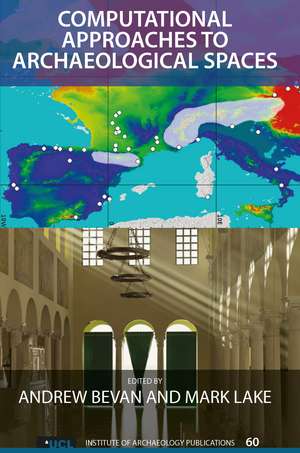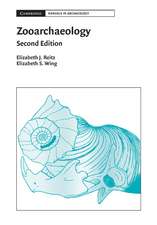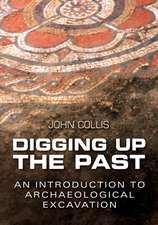Computational Approaches to Archaeological Spaces: UCL Institute of Archaeology Publications
Editat de Andrew Bevan, Mark Lakeen Limba Engleză Paperback – 29 apr 2022
| Toate formatele și edițiile | Preț | Express |
|---|---|---|
| Paperback (1) | 782.44 lei 43-57 zile | |
| Taylor & Francis – 29 apr 2022 | 782.44 lei 43-57 zile | |
| Hardback (1) | 1120.91 lei 22-36 zile | |
| Taylor & Francis – 31 aug 2013 | 1120.91 lei 22-36 zile |
Din seria UCL Institute of Archaeology Publications
-
 Preț: 413.33 lei
Preț: 413.33 lei -
 Preț: 312.56 lei
Preț: 312.56 lei -
 Preț: 288.80 lei
Preț: 288.80 lei -
 Preț: 356.44 lei
Preț: 356.44 lei - 12%
 Preț: 340.69 lei
Preț: 340.69 lei -
 Preț: 502.75 lei
Preț: 502.75 lei - 31%
 Preț: 765.68 lei
Preț: 765.68 lei - 16%
 Preț: 245.83 lei
Preț: 245.83 lei -
 Preț: 352.41 lei
Preț: 352.41 lei -
 Preț: 349.80 lei
Preț: 349.80 lei - 25%
 Preț: 1022.48 lei
Preț: 1022.48 lei -
 Preț: 386.31 lei
Preț: 386.31 lei -
 Preț: 414.53 lei
Preț: 414.53 lei - 25%
 Preț: 1005.92 lei
Preț: 1005.92 lei -
 Preț: 370.87 lei
Preț: 370.87 lei -
 Preț: 384.02 lei
Preț: 384.02 lei - 15%
 Preț: 582.24 lei
Preț: 582.24 lei -
 Preț: 368.76 lei
Preț: 368.76 lei -
 Preț: 346.71 lei
Preț: 346.71 lei - 17%
 Preț: 240.42 lei
Preț: 240.42 lei - 15%
 Preț: 249.80 lei
Preț: 249.80 lei - 26%
 Preț: 1044.60 lei
Preț: 1044.60 lei - 18%
 Preț: 782.44 lei
Preț: 782.44 lei - 29%
 Preț: 1020.09 lei
Preț: 1020.09 lei - 21%
 Preț: 364.86 lei
Preț: 364.86 lei -
 Preț: 349.71 lei
Preț: 349.71 lei - 15%
 Preț: 669.94 lei
Preț: 669.94 lei - 18%
 Preț: 1128.91 lei
Preț: 1128.91 lei - 18%
 Preț: 1082.83 lei
Preț: 1082.83 lei -
 Preț: 389.66 lei
Preț: 389.66 lei - 17%
 Preț: 247.40 lei
Preț: 247.40 lei -
 Preț: 354.71 lei
Preț: 354.71 lei - 19%
 Preț: 241.15 lei
Preț: 241.15 lei - 16%
 Preț: 264.12 lei
Preț: 264.12 lei - 17%
 Preț: 246.84 lei
Preț: 246.84 lei - 26%
 Preț: 1014.74 lei
Preț: 1014.74 lei -
 Preț: 349.80 lei
Preț: 349.80 lei
Preț: 782.44 lei
Preț vechi: 954.19 lei
-18% Nou
Puncte Express: 1174
Preț estimativ în valută:
149.72€ • 156.72$ • 124.61£
149.72€ • 156.72$ • 124.61£
Carte tipărită la comandă
Livrare economică 31 martie-14 aprilie
Preluare comenzi: 021 569.72.76
Specificații
ISBN-13: 9781611323474
ISBN-10: 1611323479
Pagini: 330
Dimensiuni: 152 x 229 x 18 mm
Greutate: 0.45 kg
Ediția:1
Editura: Taylor & Francis
Colecția Routledge
Seria UCL Institute of Archaeology Publications
Locul publicării:Oxford, United Kingdom
ISBN-10: 1611323479
Pagini: 330
Dimensiuni: 152 x 229 x 18 mm
Greutate: 0.45 kg
Ediția:1
Editura: Taylor & Francis
Colecția Routledge
Seria UCL Institute of Archaeology Publications
Locul publicării:Oxford, United Kingdom
Cuprins
List of Illustrations
Acknowledgments
1. Introduction,Andrew Bevan and Mark Lake
2. Intensities, Interactions and Uncertainties: Some New Approaches to Archaeological Distributions, Andrew Bevan, Enrico Crema, Xiuzhen Li and Alessio Palmisano
3. An Examination of Automated Archaeological Feature Recognition in Remotely Sensed Imagery, Kenneth Kvamme
4. An Introduction to Integrative Distance Analysis (IDA), Terence Clarke
5. Network Models and Archaeological Spaces, Ray Rivers, Carl Knappett, and Timothy Evans
6. Multilevel Selection and the Evolution of Food Sharing in Fragmented Environments: A Spatially Explicit Model and its Implications for Early Stone Age Archaeology, L.S. Premo
7. Stories of the Past or Science of the Future? Archaeology and Computational Social Science, Michael Barton
8. The Potential and Limits of Optimal Path Analysis, Irmela Herzog
9. Compute-Intensive GIS Visibility Analysis of the Settings of Prehistoric Stone Circles, Mark Lake and Damon Ortega
10. Reconsidering the Concept of Visualscape: Recent Advances in Three-Dimensional Visibility Analysis, Eleftheria Paliou
11. Formal and Informal Analysis of Rendered Space: The Basilica Portuense, Graeme Earl, Vito Porcelli, Constantinos Papadopoulos, Gareth Beale, Matthew Harrison, Hembo Pagi and Simon Keay
12. Reproducible Data Analysis and the Open Source Paradigm in Archaeology, Benjamin Ducke
Index
About the Editors/Contributors
Acknowledgments
1. Introduction,Andrew Bevan and Mark Lake
2. Intensities, Interactions and Uncertainties: Some New Approaches to Archaeological Distributions, Andrew Bevan, Enrico Crema, Xiuzhen Li and Alessio Palmisano
3. An Examination of Automated Archaeological Feature Recognition in Remotely Sensed Imagery, Kenneth Kvamme
4. An Introduction to Integrative Distance Analysis (IDA), Terence Clarke
5. Network Models and Archaeological Spaces, Ray Rivers, Carl Knappett, and Timothy Evans
6. Multilevel Selection and the Evolution of Food Sharing in Fragmented Environments: A Spatially Explicit Model and its Implications for Early Stone Age Archaeology, L.S. Premo
7. Stories of the Past or Science of the Future? Archaeology and Computational Social Science, Michael Barton
8. The Potential and Limits of Optimal Path Analysis, Irmela Herzog
9. Compute-Intensive GIS Visibility Analysis of the Settings of Prehistoric Stone Circles, Mark Lake and Damon Ortega
10. Reconsidering the Concept of Visualscape: Recent Advances in Three-Dimensional Visibility Analysis, Eleftheria Paliou
11. Formal and Informal Analysis of Rendered Space: The Basilica Portuense, Graeme Earl, Vito Porcelli, Constantinos Papadopoulos, Gareth Beale, Matthew Harrison, Hembo Pagi and Simon Keay
12. Reproducible Data Analysis and the Open Source Paradigm in Archaeology, Benjamin Ducke
Index
About the Editors/Contributors
Recenzii
“The papers in this edited volume, which grew out of a 2010 University College London international archaeology seminar, are organized around three broad themes: spatial analysis, spatial modeling, and spatial experience. Roughly one-third of the book is devoted to each topic. The first set of three papers represents inductive, exploratory approaches to archaeological spatial analysis. The second set comprises four chapters offering more deductive and model-driven approaches. These first seven chapters of the book are the most interesting and, arguably, the most useful to the majority of analysts. The final set of three articles concerns the analysis of viewsheds, visualscapes, and 3D architectural models....
Summing Up: Recommended. Graduate students/faculty/professionals.”
—CHOICE
Summing Up: Recommended. Graduate students/faculty/professionals.”
—CHOICE
Descriere
This volume of original chapters written by experts in the field offers a snapshot of how historical built spaces, past cultural landscapes, and archaeological distributions are currently being explored through computational social science.














